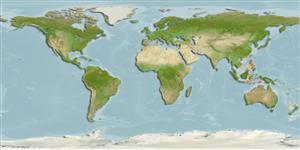Holocephali (chimeren) (chimaeras) >
Chimaeriformes (Chimaeras) >
Chimaeridae (Shortnose chimaeras or ratfishes)
Etymology: Hydrolagus: hydro-, combining form of hydor (Gr.), water; lagos (Gr.), hare, i.e., “water rabbit,” probably referring to three pairs of tooth plates, which tend to protrude from the mouth like a rabbit’s incisors. (See ETYFish); deani: In honor of American ichthyologist Bashford Dean (1867‒1928), for his “able studies” of chimaeras. (See ETYFish).
More on authors: Smith & Radcliffe.
Environment: milieu / climate zone / depth range / distribution range
Ecologie
marien bathydemersaal; diepte 469 - 770 m (Ref. 9904). Deep-water
Western Central Pacific: known only from the Philippines.
Grootte / Gewicht / Leeftijd
Maturity: Lm ? range ? - ? cm
Max length : 67.0 cm TL mannelijk / geslacht onbekend; (Ref. 9904); 73.0 cm TL (female)
Rare and limited to the upper slope. Oviparous (Ref. 205). Eggs are encased in horny shells (Ref. 205). Biology and utilization unknown in the area (Ref. 9904).
Levenscyclus en paargedrag
Maturiteit | Voortplanting | Paaien | Eieren | Fecunditeit | Larven
Smith, H.M., 1912. The chimaeroid fishes of the Philippine Islands with description of a new species. Proc. U.S. Natl. Mus. 42(1899):231-232. (Ref. 5283)
Status op de Rode Lijst van het IUCN (Ref. 130435)
Gevaar voor de mens
Harmless
Gebruik door de mens
Visserij: van geen belang
Meer informatie
Leeftijd/Grootte
Groei
Lengte-gewicht
Lengte-lengte
Lengtefrequenties
Morfometrie
Morfologie
Larven
Larvale populatiedynamiek
Rekrutering
Abundantie
BRUVS
ReferentiesAquacultuurAquacultuurprofielKweeklijnenGeneticaElectrophoresesErfelijkheidZiektesVerwerkingNutrientsMassaconversie
Tools
Speciale rapporten
Download XML
Internetbronnen
Estimates based on models
Preferred temperature (Ref.
123201): 6.2 - 9.8, mean 7.5 °C (based on 119 cells).
Fylogenetische diversiteitsindex (Ref.
82804): PD
50 = 0.5000 [Uniqueness, from 0.5 = low to 2.0 = high].
Bayesian length-weight: a=0.00282 (0.00118 - 0.00673), b=3.10 (2.89 - 3.31), in cm total length, based on LWR estimates for this (Sub)family-body shape (Ref.
93245).
Trofisch niveau (Ref.
69278): 3.8 ±0.6 se; based on size and trophs of closest relatives
Weerstandsvermogen (Ref.
120179): laag, minimale populatieverdubbelingstijd 4,5-14 jaar (Assuming Fec <100).
Fishing Vulnerability (Ref.
59153): Moderate to high vulnerability (49 of 100).
